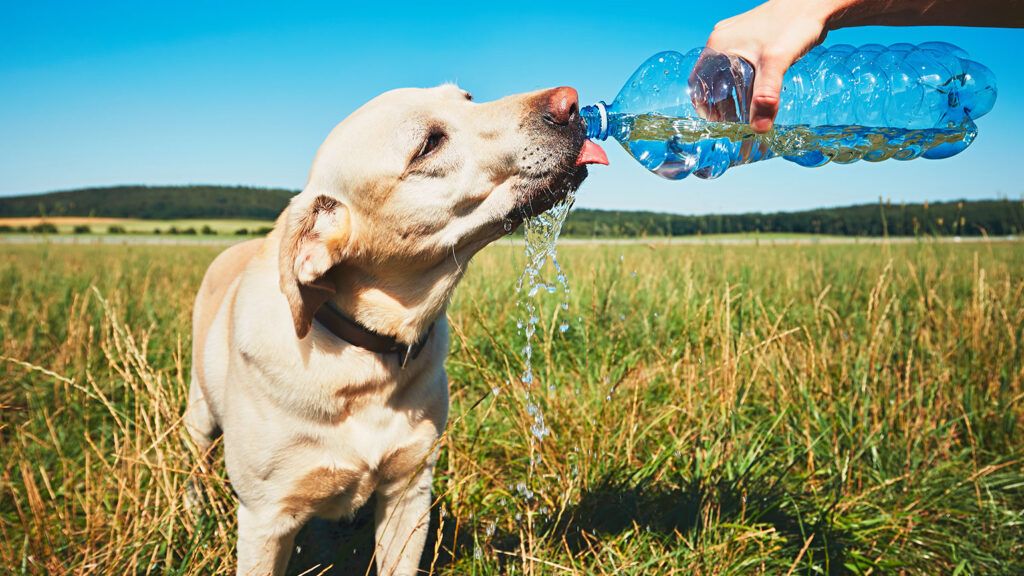1. Sunscreen isn’t just for humans.
Dogs can get sunburns, too. While their fur protects most of their skin, exposed areas such as the nose, ears and groin are vulnerable. The most susceptible breeds are white or light-colored short-haired dogs. To protect your pup, apply canine-specific sunscreen to exposed skin. According to Petmd.com, you can also use a sunscreen made for babies or sensitive skin—just be sure it’s PABA-free and doesn’t contain zinc oxide, which is toxic if ingested.
2. Not every dog can swim.
A dip in the pool or lake can be refreshing, but don’t assume your dog knows how to swim. Some dogs are naturals in the water, while others can’t even doggie paddle. Brachycephalic (“short-headed”) breeds like pugs and bulldogs have to tilt their heads up so high to breathe that it causes their bodies to be vertical in the water, making it hard to stay afloat.
Start off in shallow water with your dog on a leash. Gradually walk into deeper water until he starts paddling his front legs. Use your arm to support his belly while he learns to paddle with his hind legs as well. If your dog is not a strong swimmer, or if you’re on a boat, always use a flotation vest. There are sizes for every breed—and even for cats. Pamela Webster of Ithaca, New York, who sails with her golden retriever, Honey, says, “Another reason to put a life jacket on your cat or dog is because it gives you a handle to grab if he falls in the water.” If your dog doesn’t enjoy swimming, try cooling him off under a sprinkler or in a kiddie wading pool. P.S.: Don’t let your dog drink lake, river, ocean or pool water. It can make him sick. Bring fresh water for him.
3. Never leave your pet alone in a car.
Too many pets needlessly suffer or even die of heatstroke from being trapped inside a hot car. Parking in the shade and cracking the windows aren’t enough to keep them cool. Studies have shown that lowering car windows a couple of inches has only a minimal effect on the internal temperature. Even on a 70-degree day, the temperature inside your car can soar to more than 100 degrees in a matter of minutes. Opt for pet-friendly shops and drive-through restaurants when on the road, or bring a friend who can sit with your pet while you run inside. Some states have laws against leaving pets unattended in cars. Go to animal law.info to learn more.
Get the new daily devotion for animal lovers!
4. Skip the summer shave.
Your pet’s coat is designed to keep her cool in the summer and warm in the winter. A trim is fine, but shaving your dog or cat down to the skin for summer is unnecessary. In fact, it can lead to sunburn, skin injuries and, in double-coated dogs, problems with the fur growing back properly. If you need to shave your pet for medical reasons, protect her skin with a T-shirt, limit playtime outdoors and be sure there are plenty of shady spots for her to rest in.
5. The heat can affect their feet.
Walking barefoot on hot pavement or sand can hurt, right? The same goes for your dog. Walking on hot concrete or streets can cause burns and painful blisters on paw pads. One solution is dog booties. If your dog won’t keep them on, save your walks for early morning or later in the evening, or stick to grass and shaded surfaces. Being mindful of these concerns will not only keep your pets safe but also allow them to enjoy the summer with you. And that includes frozen treats! Check the supermarket or make your own pet popsicles with foods your dog or cat normally eats. Try plain yogurt and ripe banana: Mash the banana, mix with yogurt and freeze.
For more inspiring animal stories, subscribe to All Creatures magazine.





